Creative Workshop Exercises #1 Using Positive Emotions Cards to increase learning and wellbeing for individuals and groups
Impact: Increased Learning and Wellbeing for Individuals and Groups
Materials needed: Positive Emotions Cards: How to Feel Good by Appreciating Change
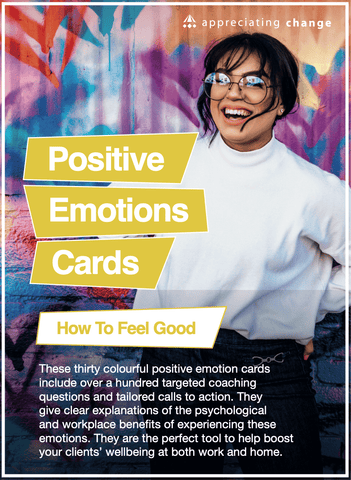
Professional use: Coaching, Counselling, Therapy, Consulting, Education and Training.
You can download this blog here
Who is this activity for?
Individuals
The activity described here is designed for use with anyone who needs to expand their understanding of, and ability to feel, positive emotions. For example people experiencing persistent low mood or those stressed and anxious. People who want to better understand, and be able to talk about, their emotions and emotional states. Anyone who wants to extend their emotional vocabulary, even fiction writers for example.
In the workplace
This activity is useful for people contemplating a career move or a new job, helping them identify what emotional experiences they are seeking. It can be used to support appraisal and performance development activity, helping to highlight and expand moments of peak performance or future aspirations. It is useful for eliciting learning from the best of the past during team de-briefing and other situations. It can be a useful part of preparation for any event or project. It is invaluable in discussions re culture building, creating flourishing organizations or the employee and customer experience. We can use this exercise to talk about the emotional component of performance, wellbeing, culture, team life and much more.
How does it help with learning and wellbeing?
Learning about, and exploring in depth, different ways to feel good expands our ability to experience these emotions. But more than that, we can learn to seek out positive emotional experiences; we can learn to boost our own mental health.
Positive emotional feelings are key to our emotional and mental health: once an experience is identified and named, we are more likely to recognize it next time it happens. The more we are able to experience positive emotional states, the better our wellbeing is likely to be.
How to conduct the Let’s Talk about Feeling Good exercise with an individual
Preparation
(Note all cards in the pack are double sided)
1 - Take the ‘how to use' card out of the pack and put it aside.

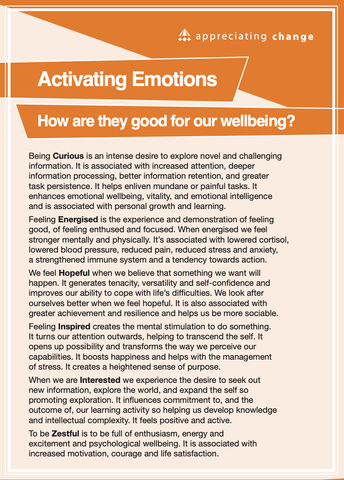
3 - Turn the title card onto its reverse to show how the thirty emotions are grouped into categories. Keep this aside for reference during the exercise.

The exercise
1 - Spread the thirty picture cards out picture side up and ask the person to pick any one of the emotions that catches their interest. Let’s imagine they pick ‘Feeling Hopeful’, an orange card.

2 - Ask them to describe what the emotion they selected means to them at this point in their life, why they chose it or were drawn to it. Note this can elicit a variety of responses from ‘it’s how I feel now’ to ‘I’ve never experienced this feeling’ giving lots of scope for different conversations.
3 - Look at the definition on the front of the card, in this case ‘Confidence about one’s ability to achieve future goals’. How well does this capture their sense of, or experience of the emotion? What do they believe this feeling does, or maybe could do, for them?
4 - Next, pick up the introductory card for that colour-coded section of cards (so in this case the orange introductory card) from the 5 you put aside earlier and share with them how that emotion has been shown to be good for our wellbeing. Ask them how these potential benefits resonates with their experience or their need. With the Feeling Hopeful card we can see that it ‘generates tenacity, versality and self-confidence...’
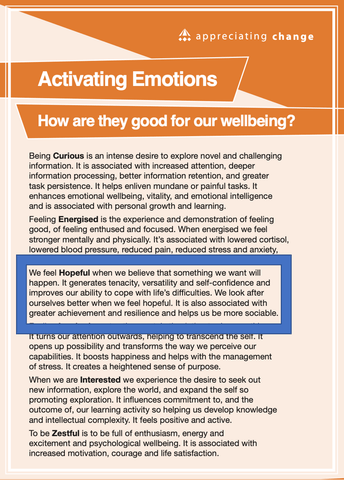
6 - You can expand this section of the exercise by looking at the grouping the emotion fits within. How does this relate to their selection of this card? For example, if they selected ‘Feeling Hopeful’ you can inquiry whether they feel the need to be more active or motivated generally, or is it a feeling of hope that they specifically seek.

7 - Now turn the card, in our example Feeling Hopeful over. Use the questions on the back to stimulate an in-depth discussion about their experience of hope and hopefulness.
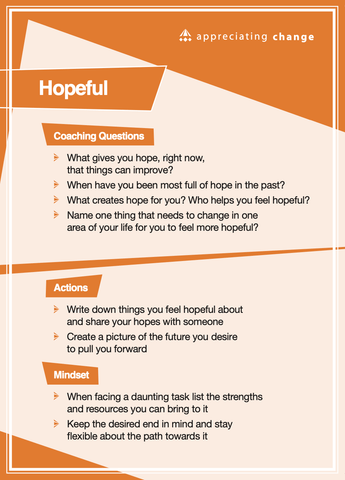
8 - When it feels appropriate, move on to looking at the possible actions to help build more hope into life, including the mindset suggestions. Investigate whether they can be applied to a current or forthcoming activity or challenge.
9 - Wrap up the session by jointly reflecting on the conversation and what illuminations or insights have flowed from it. End by clarifying what the person might do to encourage more of the emotion that has been explored to enter their life.
How to conduct the Let’s Talk about Feeling Good exercise with a group
Preparation
- Divide the pack or packs of cards into the colour-coded category sections.
- Clarify what the group is focussing on e.g. developing a flourishing culture, reflecting on a completed project, planning for a forthcoming event.
- Break the whole group into five or more subgroups.
The Exercise
1 - Give each sub-group one section of emotions e.g. activating or soothing etc., including the benefits card (for example these are all the relational emotions laid out below).
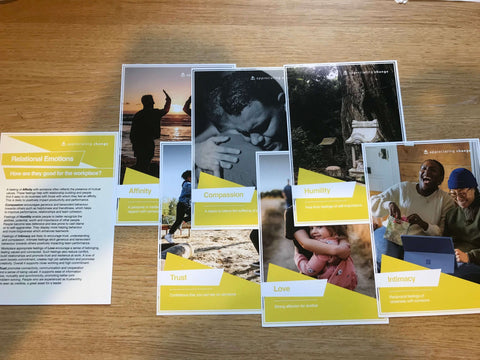
2 - Ask each group first to identify which of the emotions in their mini-pack they think was most beneficially present (if reviewing the past), or is most desirable (if planning for the future).
3 - Then ask them to think about how experiencing this emotion added (to the past) or will add (in the future), referring to the benefits card to help their discussion.
4 - Ask each group in turn to share their chosen emotion and their thoughts about its value to the experience or aspiration under discussion. Clearly from here you can take the discussion in many different directions. For example, asking whether it was harder to identify something from one category than another? What does that tell us about the experience, about the organization, or for the future?
5 - To take the conversation further swap tables so each group is working with a different set of cards (to expose them to a different category) and ask them which of these they feel it is most important for people on the team, job, project, or in the organization to experience at work.
6 - Take feedback from each table, asking them to expand one their choice
7 - Turning all the selected cards over so that the actions are exposed for each selected emotion, ask each table to contribute an idea for how to work together to make the experience of that emotion more likely in the future. They can use ideas from the card, or self-generated ideas.
This card pack is available exclusively at the Positive Psychology Shop. A discount of 10% is available to newsletter subscribers for the next week using the code.
If you have any queries about the exercises as described, please contact Sarahlewis@acukltd.com. We will publish any queries and answers in the next newsletter to the benefit of all.
Please feel free to share the link to this page with any colleagues you feel may be interested. Or, direct them to the homepage where they can subscribe to the newsletter for free. Many thanks


